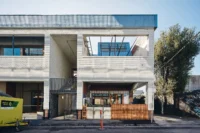Situated on the threshold between a commercial industrial zone and a quiet residential neighbourhood, Sanders Place represents the sensitive transformation of a 1970s two-storey brick factory into a light-filled, energy-positive co-working hub. Designed by NMBW Architecture Studio, the project reimagines an introverted and closed-off industrial building into an inviting workplace, fully integrated with its urban surroundings through a series of landscaped courtyards and new spatial connections.
From the outset, the ambition was to create a co-working environment that would feel as warm and welcoming as a home while achieving the highest standards in environmental performance. This goal was pursued through a deeply collaborative design process, bringing together the architect, landscape architect, and ESD consultant as equal partners from the earliest design stages. The result is a building that not only minimises its ecological footprint but also fosters community, productivity, and wellbeing.

Adaptive Reuse and Sustainable Strategies
The project embraces the principles of adaptive reuse, treating demolition as carefully as construction. Materials removed from the existing building were thoughtfully salvaged, cleaned, and stored for re-use within the project. This approach significantly reduced waste and preserved the embodied energy of original materials. Large sections of demolished Oregon floor joists, for instance, were transformed by a skilled woodworker into bespoke furniture pieces, including a communal bench that celebrates the timber’s natural patina and history.
In line with the energy-positive objective, the building now generates electricity through a rooftop solar PV system and dramatically reduces energy demand through high thermal performance and Heat Recovery Ventilation (HRV) systems. Every design move is underpinned by a sustainable logic, from the airtight wrapping of the existing structure to the strategic introduction of natural light and ventilation pathways.
Courtyards as Social and Climatic Anchors
A defining feature of Sanders Place is the introduction of four distinct courtyards, each playing a role in enhancing daylight, natural ventilation, and social interaction. These courtyards also provide a visual connection between occupants and the surrounding community, softening the building’s industrial edges.
-
The central internal courtyard rises through a newly created void in the first-floor slab, allowing plants to grow vertically through the building’s heart. Groundcovers and plant species were selected to thrive in unconditioned interior spaces, creating a lush microclimate.
-
Corner external courtyards provide varied atmospheres and microclimates, including a productive kitchen garden that supports communal meals and fosters a sense of shared stewardship.
These spaces are more than aesthetic gestures—they form part of the building’s environmental system, moderating temperature, improving air quality, and supporting biodiversity.

Structural Interventions and Spatial Logic
Reworking the factory’s dense and enclosed interior required bold structural interventions. Openings were cut through the existing slabs to create double-height volumes, sky lanterns, and generous light wells. A large hole saw was used to core the existing concrete ground floor slab, revealing the natural ground below and creating deep planting zones.
The reconfigured circulation weaves between enclosed work areas, shared lounges, and open-air gardens, allowing occupants to move fluidly between focused work and social exchange. This new spatial logic reinforces the feeling of a domestic environment—comfortable, informal, and human-scaled—while maintaining the flexibility required of a shared workspace.
Craft and Community in the Making
The collaborative spirit extended beyond the design team to include the builder and specialist makers. The construction process was hands-on and meticulous, with tradespeople actively engaged in problem-solving and material innovation. The crafted timber furniture, for example, not only reuses salvaged material but also reflects the project’s broader ethos: to value the existing, to work with it respectfully, and to adapt it to new purposes without erasing its history.

A Model for Regenerative Urban Workspaces
Sanders Place stands as a compelling example of how disused industrial buildings can be regenerated to meet contemporary work needs while maintaining strong ties to their history and context. It demonstrates that sustainability in architecture is as much about cultural and social continuity as it is about environmental performance.
By combining adaptive reuse, energy generation, landscape integration, and human-centred design, NMBW Architecture Studio has created a workplace that is not only low-impact but also deeply enriching for its users and community. The building now engages with the street and neighbouring laneways through its courtyards, inviting interaction and curiosity from passers-by.
What was once a sealed, energy-hungry brick box has been reborn as a vibrant, light-filled, and ecologically responsible co-working hub—one that demonstrates how careful design can turn an industrial relic into a living, breathing part of the city’s future.
Photography: Peter Bennetts
- Adaptive reuse industrial building
- Australian architecture sustainable
- Brick factory transformation
- Co-working hub with courtyards
- Collaborative architectural process
- Eco-friendly workplace design
- Ecological footprint reduction
- Energy-positive architecture project
- Heat Recovery Ventilation HRV
- Human-centred office design
- Industrial heritage reuse
- Landscape architecture courtyards
- Natural ventilation design
- NMBW Architecture projects
- Regenerative urban workspace
- Sanders Place NMBW Architecture
- Solar PV architecture integration
- Sustainable architectural renovation
- Sustainable co-working space design
- Timber furniture reuse




































Leave a comment